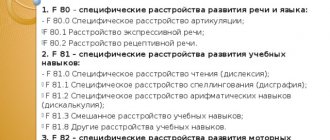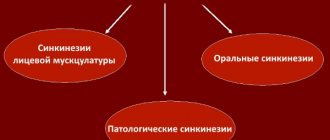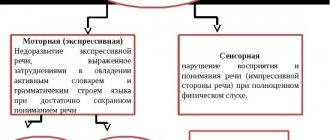Speech therapy diagnostics has been experiencing a crisis for a long time and does not yet satisfy the requirements of both science and practicing speech therapists. Speech therapy conclusions are defined and formulated differently in different regions, cities, and districts. Thus, there are differences in the approach of Moscow and St. Petersburg speech therapy schools to the formulation of speech therapy conclusions. There is also a discrepancy between the conclusions corresponding to the classification of speech disorders and the requirements of the pedagogical administration. In some recommendations for the formulation of speech therapy conclusions, the diagnosis of general speech underdevelopment (GSD) dominates. Against the background of criticism of the existing shortcomings in speech therapy diagnostics, there are attempts to replace traditional speech therapy classifications with clinical, medical classifications that are too detailed and descriptive, which are not focused on solving practical problems of correcting speech disorders. The problem of diagnosing speech disorders is of great theoretical and practical importance. From a theoretical point of view, the issue of diagnosing speech disorders is related to the problem of speech disorders. From a practical point of view, a well-founded solution to this issue contributes to a more correct staffing of speech groups, the selection and referral of children to mainstream and special schools, and a more targeted and differentiated speech therapy intervention. The problem of classification of speech disorders is relevant in many sciences that study speech. Speech is a complex physiological, mental, mental, linguistic, sensorimotor process, in which both more elementary (sensorimotor, gnostic-practical) and highly organized levels (semantic, linguistic) are intertwined. In this regard, speech and its disorders are studied by many sciences: medicine, psychology, linguistics, psycholinguistics, etc. At the same time, they also relate to the classification of speech disorders in various aspects: clinical, pathophysiological (taking into account the analyzer principle, the nature of disorders of the language system), psycholinguistic . In speech therapy, there are two traditional classifications of speech disorders: psychological-pedagogical and clinical-pedagogical. These classifications consider speech disorders in various aspects. But at the same time, the data of both classifications complement each other and serve common tasks: recruiting groups of children with speech pathology and implementing systemic, differentiated speech therapy treatment, taking into account the symptoms and mechanisms of speech disorders. The psychological and pedagogical classification is focused on identifying primarily speech symptoms (symptomological level) based on psychological and linguistic criteria. The symptomological level of analysis of speech disorders makes it possible to describe the external symptoms of language (speech) underdevelopment in children, to identify impaired components of speech (general underdevelopment, phonetic-phonemic underdevelopment, etc.), which serves as the basis for sending children to the appropriate groups of kindergarten or to a certain type of school. Thus, determining the symptomological level of speech disorders solves, first of all, the practical problems of recruiting groups and creates the prerequisites for determining the nature of speech pathology. It is known that with the same pathology (form of speech disorder), the language system can suffer in different ways. Conversely, the same symptoms can be observed in forms of speech disorders with different mechanisms. So, for example, general underdevelopment of speech can be observed with an erased form of dysarthria, with motor alalia, with childhood aphasia. In the process of speech therapy work, it is important to take into account both the level of unformed speech, impaired components of speech, and the mechanisms and forms of speech disorders. The unity of these two aspects of speech therapy diagnostics makes it possible to correct speech disorders in a more differentiated manner. Speech therapy diagnostics should proceed from the general to the specific: from identifying a complex of speech symptoms to clarifying the mechanisms of speech pathology, to clarifying the interaction between speech and non-speech symptoms, to determining the structure of the speech defect. The clinical and pedagogical classification is not strictly correlated with clinical syndromes. She focuses on those disorders that should be the object of speech therapy. In the process of making a speech therapy report, medical data and clinical characteristics are necessary, which make it possible to clarify a particular speech therapy diagnosis. Clinical characteristics are focused on explaining the causes of speech disorders, on treating the child, and not on the system of correction and speech development. Currently, both clinical-pedagogical and psychological-pedagogical classifications need clarification and expansion. For example, the practice of school speech therapists shows that as violations of sound pronunciation and phonemic development are corrected, there is no reason to talk about OHP. However, for a long time, children continue to have underdevelopment of the lexico-grammatical structure of speech, which leads to great difficulties in mastering the Russian language program, assimilation and implementation of spelling rules. Therefore, there is reason, along with ONR, NONR (mildly expressed general underdevelopment of speech), to highlight lexico-grammatical underdevelopment of speech. It is necessary to clarify the forms of speech disorders within the clinical and pedagogical classification. Summary. To staff speech groups in kindergartens, send children to schools of a certain type and carry out differentiated correctional and speech therapy work, both criteria for speech therapy diagnostics are important: symptomological and clinical-pedagogical. Speech therapy diagnostics, which sets correctional and developmental tasks, should be considered within the framework of the existing classifications in speech therapy (psychological-pedagogical and clinical-pedagogical), and the speech therapy conclusion should take into account the intersection of these two classifications. When formulating a speech therapy report, it is also advisable to take into account the stages of the examination: from determining the symptoms of speech disorders, identifying impaired components to clarifying the mechanisms and structure of the speech defect (i.e., the form of speech disorders).
SLOGOPEDIC CONCLUSION WHEN EXAMINING PRESCHOOL CHILDREN Examination of preschool children with normal intelligence In the speech therapy report, it is recommended to indicate the nature of speech disorders based on both classifications. 1. Symptomological (psychological and pedagogical) classification takes into account which components of speech are impaired and to what extent. This classification contains the following groups of speech disorders: - Phonetic speech disorder (FSD) or impaired pronunciation of individual sounds (NPOS). In case of FND, the phonetic aspect of speech (sound pronunciation, sound-syllabic structure of a word, prosody) as a whole or any individual components of the phonetic structure of speech (for example, only sound pronunciation or sound pronunciation and sound-syllabic structure of a word) are impaired. — Phonetic-phonemic speech disorder (FFSD). With FFND, along with a violation of the phonetic aspect of speech, there is also an underdevelopment of phonemic processes: phonemic perception (auditory differentiation of sounds), phonemic analysis and synthesis, phonemic representations. — Lexico-grammatical underdevelopment of speech (LGNR). With LGNR, children have normal sound pronunciation, phonemic processes are relatively preserved (most often as a result of speech therapy), but there is a limited vocabulary and a violation of the grammatical structure of speech. — General underdevelopment of speech (GSD levels I, II and III), as well as mild general underdevelopment of speech (GONSD). With OHP in children, all components of the language (speech) system are impaired: the phonetic-phonemic side of speech, vocabulary, grammatical structure.
2. Clinical and pedagogical classification reveals the mechanisms, forms and types of speech disorders. The following forms of speech disorders are taken into account: dyslalia, dysarthria or an erased form of dysarthria, rhinolalia, voice disorders, motor, sensory alalia, childhood aphasia, speech development delay (SRD), general speech underdevelopment with mental retardation (MDD), OSD of unknown pathogenesis , stuttering, tachylalia, stumbling (poltern). Options for the intersection of two classifications. • Phonetic speech disorder (FSD) or disorder of pronunciation of individual sounds (NPOS): - dyslalia, - dysarthria or erased dysarthria, - voice disorders, - rhinolalia. • Phonetic-phonemic speech disorder (FFSD): - dyslalia, - dysarthria or erased dysarthria, rhinolalia. • Underdevelopment of the lexico-grammatical structure of speech (LGNR): exit from motor (sensory) alalia, similar to delayed speech development, with mental retardation, unknown pathogenesis. • General speech underdevelopment (GSD levels I, II, III, NOSD): motor alalia, sensory alalia, - sensorimotor alalia, dysarthria or erased dysarthria, as a type of delayed speech development, with mental retardation, - unknown pathogenesis.
Violation of the tempo and rhythm of speech: stuttering, tachylalia, bradyllalia, stumbling (poltern). Approximate wording of a speech therapy report General speech underdevelopment (level I). Motor alalia. General speech underdevelopment (level I). Sensory alalia. General speech underdevelopment (level I). Erased pseudobulbar dysarthria. General speech underdevelopment (level I). Motor alalia, stuttering. General speech underdevelopment (level I). Sensorimotor alalia. General speech underdevelopment. Childhood aphasia. General speech underdevelopment (II level). Erased pseudobulbar dysarthria. General speech underdevelopment (II level). Motor alalia. General speech underdevelopment (II level). Motor alalia, stuttering. Lexico-grammatical underdevelopment of speech. Exit from motor alalia. Phonetic-phonemic speech disorder. Erased pseudobulbar dysarthria.
Phonetic-phonemic speech disorder. Open organic rhinolalia. Phonetic speech disorder. Motor functional dyslalia. Phonetic speech disorder. Open organic rhinolalia. Examination of preschool children with mental retardation The term “ONR”, proposed by R. E. Levina and the staff of the Research Institute of Defectology (Fundamentals of the theory and practice of speech therapy / Edited by R. E. Levina. - M., 1968), is defined as follows: “General underdevelopment speech – various complex speech disorders in which children have impaired formation of all components of the speech system related to its sound and semantic side, with normal hearing and intelligence.” In accordance with the definition, the term “ONR” cannot be used in speech therapy diagnosis of speech disorders in mentally retarded children. To indicate the immaturity of speech as a system in mentally retarded children, the following formulations of a speech therapy report are recommended (for preschoolers 5-7 years old).
1. Systemic underdevelopment of severe speech in mental retardation Speech therapy characteristics: polymorphic disorder of sound pronunciation, absence of both complex and simple forms of phonemic analysis, limited vocabulary (up to 10-15 words). Phrasal speech is represented by one-word and two-word sentences consisting of amorphous root words. There are no forms of inflection and word formation. Coherent speech is not formed. Severe impairment of speech understanding.
2. Moderate systemic underdevelopment of speech in mental retardation Speech therapy characteristics: polymorphic disorder of sound pronunciation, gross underdevelopment of phonemic perception and phonemic analysis and synthesis (both complex and simple forms); limited vocabulary; pronounced agrammatisms, manifested in the incorrect use of noun endings in prepositional and non-prepositional syntactic constructions, in violation of the agreement of adjective and noun, verb and noun; unformed word-formation processes (nouns, adjectives and verbs); absence or gross underdevelopment of coherent speech (1-2 sentences instead of retelling). 3. Systemic mild speech underdevelopment in mental retardation Speech therapy characteristics: polymorphic disorder of sound pronunciation, underdevelopment of phonemic perception and phonemic analysis and synthesis; agrammatisms manifested in complex forms of inflection (in prepositional-case constructions when agreeing between an adjective and a neuter noun and the nominative case, as well as in oblique cases); violation of word formation, insufficient formation of coherent speech, in retellings there are omissions and distortions of semantic links, disruption of the transmission of the sequence of events.
Speech therapy conclusion during an examination of schoolchildren Examination of schoolchildren with normal intelligence and mental retardation When determining the nature of speech disorders in school-age children, the same wording of a speech therapy report is recommended as for preschool children. In cases where schoolchildren have reading and writing impairments, the form of dyslexia and/or dysgraphia is included in the speech therapy report after determining the type of oral speech impairment. Approximate wording of a speech therapy report • OHP (level III). Exit from motor alalia. Phonemic dyslexia, dysgraphia due to impaired language analysis and synthesis. • Phonetic-phonemic speech disorder. Sensory functional dyslalia. Dysgraphia based on impaired phoneme recognition. • NONR. According to the type of speech development delay. Dysgraphia due to violations of language analysis and synthesis, agrammatic dysgraphia. • Lexico-grammatical underdevelopment. Semantic dyslexia, agrammatic dysgraphia. Examination of schoolchildren with mental retardation 1. Severe systemic underdevelopment of speech in mental retardation Speech therapy characteristics: polymorphic disorder of sound pronunciation; gross underdevelopment of phonemic perception and phonemic analysis and synthesis (both complex and simple forms); limited vocabulary; pronounced agrammatisms, manifested in violation of both complex and simple forms of inflection and word formation: in the incorrect use of reliable forms of nouns and adjectives, in violation of prepositional-case constructions, agreement between adjective and noun, verb and noun; unformed word formation; lack of coherent speech or its severe underdevelopment (1-2 sentences instead of retelling). 2. Moderate systemic underdevelopment of speech in mental retardation Speech therapy characteristics: polymorphic or monomorphic pronunciation disorder, underdevelopment of phonemic perception and phonemic analysis (in some cases there are the simplest forms of phonemic analysis, while performing more complex forms of phonemic analysis significant difficulties are observed); agrammatisms manifested in complex forms of inflection (prepositional-case constructions, agreement between an adjective and a neuter noun in the nominative case, as well as in oblique cases); violation of complex forms of word formation; insufficient formation of coherent speech (in retellings there are omissions and distortions of semantic links, a violation of the sequence of events); severe dyslexia, dysgraphia. 3. Mild systemic speech underdevelopment in mental retardation Speech therapy characteristics: sound pronunciation disorders are absent or monomorphic in nature; phonemic perception, phonemic analysis and synthesis are basically formed; there are only difficulties in determining the number and sequence of sounds on complex speech material; vocabulary is limited; in spontaneous speech, only isolated agrammatisms are noted; special research reveals errors in the use of complex prepositions, violations of agreement between adjectives and nouns in oblique plural cases, and violations of complex forms of word formation; in the retellings there are main semantic links, only minor omissions of secondary semantic links are noted, and some semantic relationships are not reflected; There is mild dysgraphia. The speech therapy report determines: 1) the degree of systemic underdevelopment of speech, 2) violations of oral speech, 3) violations of written speech. Approximate wording of a speech therapy report • Moderate systemic underdevelopment of speech in mental retardation. Erased form of pseudobulbar dysarthria. Complex form of dysgraphia (acoustic dysgraphia, dysgraphia due to impaired language analysis and synthesis). • Systemic mild speech underdevelopment with mental retardation, mechanical dyslalia. Agrammatic dyslexia and dysgraphia.
Basic formulations
Options for speech therapy conclusions for people in the early age group include the following formulations:
- Dysarthria.
- Speech development delay.
- Developmental delay and dysarthria.
May establish delayed development of speech skills and cognitive abilities. There is a possibility of delayed psycho-speech development. For some, speech development is slowed down due to a spastic-paretic symptomatic complex involving muscle tissue. In this condition, the operation of the apparatus responsible for articulation is corrected, and its motor skills are disrupted.
Dysarthria in young people is diagnosed when expressive speech skills involve the use of individual words and simplified phrases. Before this period, only speech-motor muscle disturbances can be identified - the age of the subject does not play a role. These affect both muscle tissue and the speech apparatus. When identifying this condition, the conclusion must indicate the presence of symptoms of spastic paresis. An alternative way to formulate the diagnosis is a spastic-paretic symptom.
Relevance of templates
You can find many examples of speech therapy reports. The current material allows you to get acquainted with what such documents should look like. At the same time, you need to understand: in each individual case, the conclusion must be drawn up individually. It plays a role what the distinctive features of the subject are. No matter how simple, laconic, and attractive in design the samples of speech therapy reports for a child may be, when applying the template to reality, one must be guided by the specifics of the case.
Rhinolalia
The speech therapy report may mention such a deviation. The term refers to a situation where a child’s voice timbre and ability to pronounce sounds correctly are impaired. The pathology is caused by incorrect activity of the nasal cavity when speaking. If the case is particularly severe, the violations cover up to 38 sounds.
Motor alalia is possible. If this is observed, it must also be recorded in the speech therapy report. This format is one of the most persistent variants of speech underdevelopment. It is observed if the parts of the cerebral cortex responsible for speech function are damaged. Children with this disorder begin to speak later, their vocabulary increases very slowly, and in communication, minors prefer to resort to facial expressions and gestures.
First level of development
According to the samples of speech therapy conclusions, the first level is established if the means of communication by speech are extremely few in number, the active vocabulary is formed by only a few everyday letter combinations that a person pronounces unclearly. In addition, the child can use onomatopoeia and use various sets of sounds. As a rule, such children actively use facial expressions as a communication tool and often point with gestures. A standard set of means is used by a person to indicate both an action and an object. Additionally, the child uses changes in intonation and gestures, thereby trying to create a difference in the meanings of what is spoken. Such communication can be called babbling, which in some situations becomes almost one-word sentences, but may not always be assessed as such. At the first level, the child has practically no opportunity to differentiate between actions and objects; the names of the former are replaced by words denoting objects. It is possible to replace the names of objects with words denoting an action.
As can be seen from the samples of speech therapy reports, when establishing the first level of speech development, attention is paid to the polysemy of words - as a rule, this feature is characteristic of a child at this level. A small vocabulary is mainly associated with objects and events observed by the person. Morphological details are practically not used to reflect grammar. The base of speech is root words without inflections. Phrases are formed by elements of babble. A person reproduces the described situation step by step with sounds, actively using gestures to explain what he wants. Every word used in such communication is related to the context in numerous ways, so it is impossible for an outside observer who is not inside the situation to understand what is being said.
Dysarthria
Often in samples of speech therapy reports for a child of preschool age and other age groups, you can see a mention of dysarthria. This term usually refers to a violation of the ability to pronounce sounds. Its cause is the incorrect provision by the nervous system of the apparatus that allows a person to pronounce sounds. This is observed if the subcortical brain blocks, the posterior frontal parts, are damaged for any reason. Although the speech organs are mobile, they are a rather limited phenomenon, which complicates articulation. If such a condition develops in an adult, the speech system usually does not disintegrate, but in the case of children the situation is different. Dysarthria is different in that the problem does not affect individual sounds, but the entire ability to pronounce. In a child, the muscle tissues responsible for facial expressions and speech are inactive. The child speaks unclearly, quietly, in a weak voice. Occasionally the opposite is observed - a very sharp voice. The breathing rhythm and rate of pronunciation are often disturbed. Speech with dysarthria cannot be smooth.
The mentioned violations are recorded in the speech therapy report for the child. They occur to varying degrees in different people. Various combinations of features are possible. This is determined by what kind of damage to the central nervous system and PNS there is, how they are combined, how severe they are, when they were formed.
Technical aspects
Currently, responsibility for the formation of speech therapy conclusions is assigned to specialized points. To be enrolled, you must pass a special PMPK commission, as well as receive a referral in the prescribed form. One point simultaneously serves several dozen people. The work team is selected by government agencies. Children of preschool age with speech disorders are taken on as tutors. Responsibility for making decisions on received applications rests with local commissions. They may refuse if all available places are already taken. First of all, persons with ONR from the first to third levels are enrolled, as well as in the presence of FFNR. The speech therapist conducts an initial examination. Typically, such a procedure is prescribed for the fall, and then a journal is started on the child to monitor the dynamics of the condition. Based on the results of the examination, information is sent to a council of doctors and teachers to determine the optimal method of working with the child. If there are speech disorders, a referral is made for a comprehensive analysis of the condition to the PMPK.
In order for a child to receive specialist help to correct his ability to speak, representatives of the minor must bring the commission’s conclusion to the local department responsible for education issues. If officials make a positive decision, they formalize a referral by which the child is enrolled in a speech center. During the school year, the child may be expelled if violations are ruled out. If the issue of expulsion becomes controversial, it is necessary to refer the student to a commission that will make a verdict on the case.
Second level
A specific feature is the appearance of phrases formed by two, three, and occasionally four words. At first, they seem unclear from the outside, but when analyzing speech samples, one can notice the use of amorphous words and those that have generic, case, and other categorical features. The child connects words and their combinations, tries to construct a phrase, correctly and incorrectly applying the rules of speech control. Sometimes you can hear how he independently uses simplified prepositions, sometimes - their variants characteristic of babbling. Being at the second level of development, the child may at times miss a preposition and work incorrectly with sentence elements, while the volume of words is significantly higher than is typical for the first level. You can see the adverbs. The minor begins to use numerals. At the same time, the morphological system is rather weak, only simple operations are available for forming words, therefore speech capabilities are assessed as poor, the child often makes mistakes, misunderstands a number of adjectives and prefixes denoting actions.
At the conclusion of the speech therapy examination, the second level is indicated, when in the presence of the described speech problems one can see the difficulties of using abstract terms, concepts used for generalization, antonyms and words with similar meanings. Children of this level tend to use words that imply an abundance of meanings. Coherent speaking is accompanied by a weak transmission of a number of relationships of meaning. For some, there is still only a sequential listing of everything observed.
Impaired mental function
The speech therapy report may indicate the presence of mental retardation. It is a complex disorder affecting the psyche, psychology, physical functioning and development. ZPR is a borderline variant of a violation of human formation and development. With it, mental functions are formed unevenly, and there are often combined variants of underdeveloped functions, preserved, damaged. The severity of the damage and the level of insufficient maturity vary greatly from case to case. Children, due to mental retardation, are among the most difficult for diagnosticians, especially if we are talking about very young children. Many people show signs of slow physical development. Muscle tissue develops poorly, muscle and vascular tone is reduced, growth is slow. Against the background of mental retardation, the ability to speak and walk is often slow to develop. Such children develop neatness more slowly and the stages of play are slower.
With mental retardation, there are specific nuances of will and emotions - these can also be recorded in a speech therapy report. The mentioned sphere is not mature enough, and the ability to perceive is impaired. Organic infantilism is observed. There are no bright, lively emotions inherent in children, the will is weak, as is the ability to be interested in the opinions of others about their activity. The gameplay is monotonous and monotonous. With mental retardation, there is no inclination to create, the imagination is poor, performance is low, exhaustion is increased, and memory is weak. It is difficult to attract the attention of such children for a long time, mental processes proceed slowly, and it is difficult for the child to switch between them. He needs a long time to receive and process information received through hearing and vision. The information stock about the world around with mental retardation is significantly poorer than that of peers, ideas about space and time are poorly formed, and the vocabulary is small. Teaching a child to read and write with mental retardation is very difficult; it is common for him to mix up letters that are similar in appearance.
Features of work
The speech therapist is responsible for determining the effectiveness of the chosen option for working with each child. He needs to have his speech development assessed. As a rule, the analysis is carried out at the end of spring, at which time children who received the help of speech therapists are re-diagnosed. To monitor progress, speech therapists keep individual cards for each person admitted. The teacher’s task is to organize classes that allow children to develop, taking into account the nuances of their defects. The duration of the lesson must correspond to the characteristics of children's physiology, as well as hygienic and sanitary standards adopted in our country. Subgroup work is allowed with those whose impairments are similar. With OHP, a subgroup is formed of no more than 4 people; with FFNR, it is allowed to unite up to six people. The duration of an individual lesson should not exceed a quarter of an hour. With OPD, it is necessary to work with children three times a week or more often, with FFND - twice a week or more often, and with phonetic defects - at least once a week. To record attendance, speech therapy centers are required to keep logs.
When working with children, a speech therapist should spend 70% of his time working with subgroups or individually, allocate about 20% of his time to methodological interaction and group consultation, and spend only one tenth of his working day on documenting the process. To record the success of the work, you need to keep an attendance notebook, a journal reflecting the dynamics for each student, speech cards and plans showing the prospects for each student.






